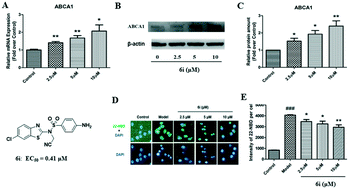Identification of N-benzothiazolyl-2-benzenesulfonamides as novel ABCA1 expression upregulators†
Abstract
ATP binding cassette transporter A1 (ABCA1) is a critical transporter that mediates cellular cholesterol efflux from macrophages to apolipoprotein A-I (ApoA-I). Therefore, increasing the expression level of ABCA1 is anti-atherogenic and ABCA1 expression upregulators have become novel choices for atherosclerosis treatment. In this study, a series of N-benzothiazolyl-2-benzenesulfonamides, based on the structure of WY06 discovered in our laboratory, were designed and synthesized as novel ABCA1 expression upregulators. Based on an in vitro ABCA1 upregulatory cell model, ABCA1 upregulation of target compounds was evaluated. Compounds 6c, 6d, and 6i have good upregulated ABCA1 expression activities, with EC50 values of 0.97, 0.37, and 0.41 μM, respectively. A preliminary structure–activity relationship is summarized. Replacing the methoxy group on the benzothiazole moiety of WY06 with a fluorine or chlorine atom and exchanging the ester group with a cyano group resulted in more potent ABCA1 upregulating activity. Moreover, compound 6i increased ABCA1 mRNA and protein expression and significantly promoted cholesterol efflux in RAW264.7 cells. In conclusion, N-benzothiazolyl-2-benzenesulfonamides were identified as novel ABCA1 expression upregulators.



 Please wait while we load your content...
Please wait while we load your content...